Celta Vigo are currently under the leadership of Eduardo Berizzo, a retired Argentina international player. Berizzo was a defender during his footballer career. His managerial experience was begun as one of Marcelo Bielsa assistant manager. This in turn, influences many things of his tactical vision. Like the many of Bielsa disciples, Berizzo’s philosophy of play revolves around intensity.
Celta Vigo line up with 4-3-3 formation. They actually play with various formations, which interesting to take lesson from. When defending, deep in their own half, Celta change their shape to 5-3-2 / 5-4-1 / 4-4-2. They sometimes seem to be playing with strikerless shape, as Larrivey and the two wide strikers are dropping deep collectively and play with two banks of five. Something they do instinctively, IMHO. Another different shape is seen, when Celta are on their high defensive block. Celta go with 4-3-3 or 4-2-4 and make sure they create enough pressure to the opposing team defensive line. Three or four men up front shape suits to such purpose.
When attack, Celta play it with either 4-3-3 or 4-2-4. Things getting more interesting if you take notice on how their wide strikers (Nolito and Orellana) playing with various way of play, which occasionally, transforms Celta shape into asymmetric one. Nolito drops very deep in line with Celta back line and Orellana stays forward or vise versa. They also known as inverted wingers who love to occupy the central area and try to overload the zone 14 respectively.
Eduardo Berizzo boys were playing highly-discipline, being the number one key why Celta Vigo manage to overtune Barcelona. Another key element was, the man to man system deploy through the match to stop Barcelona from play. And, the long ball plan which was used as their main weapon of exploiting Barcelona lack of aerial duel.
Build up play
Eduardo Berizzo has two common ways of build up play. In some matches, we he asks his boys to play out of defense and play patiently from behind. In another match (one of them is the Barca match), Berizzo choses to build up his play by playing a lot of long ball forward (right from behind). Celta tried to exploit Barcelona lack of aerial duel.
In early minute of the match against Barcelona, an interesting moment appeared, simple but smart way of escaping from opponent pressing.
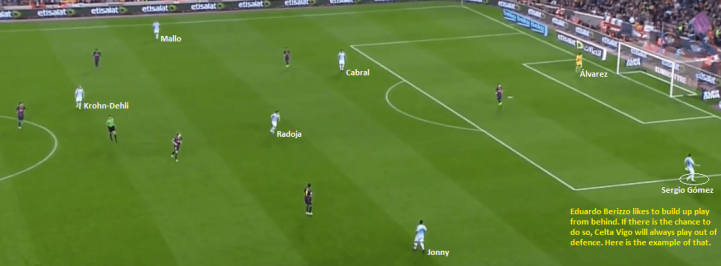
Sergio Gómez on possession. Here Celta tried to build up play from behind.
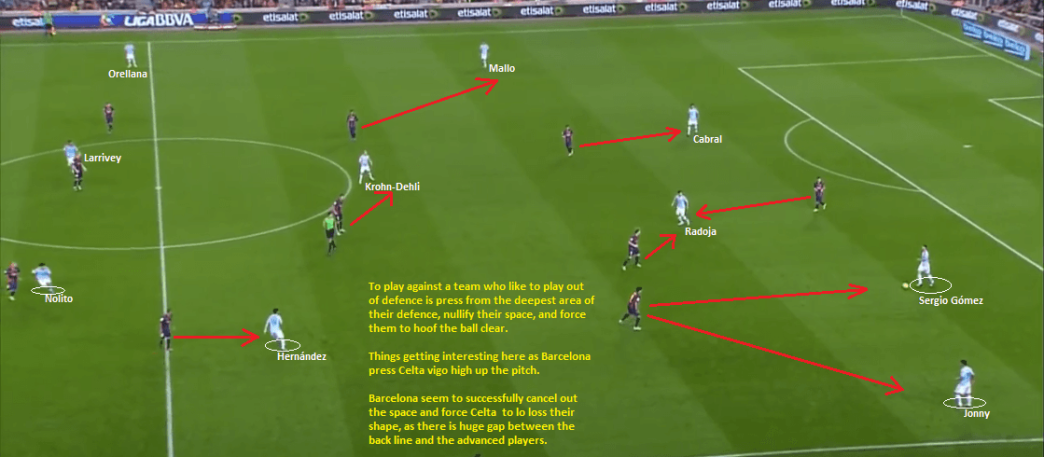
Barcelona pressed Celta Vigo. Interesting way of play here, by Celta.
When an on possession team are being pressured, deep on their defense line, that team usually have two choices to take.
(1) play long ball forward (with small chance to succeed) or (2), narrow their shape and close the distance between players, forming triangle shape to provide more passing options and try to win the “rule of number” as well.
As seen on picture, Celta Vigo didn’t try to short the distance between players. Take a look at Jonny, Hernandez, and Nolito. Instead of playing wasted long ball or narrow the shape and formed triangle shape as well, Celta Vigo deliberately enlarged the gap between their back line and the advanced players. Hernández ran forward instead of dropping deep to open another passing option for Celta back line. How come? See Nolito, he moved to the wide area, when Hernández went forward. Nolito exactly was the one who would receive the pass, not Hernández.
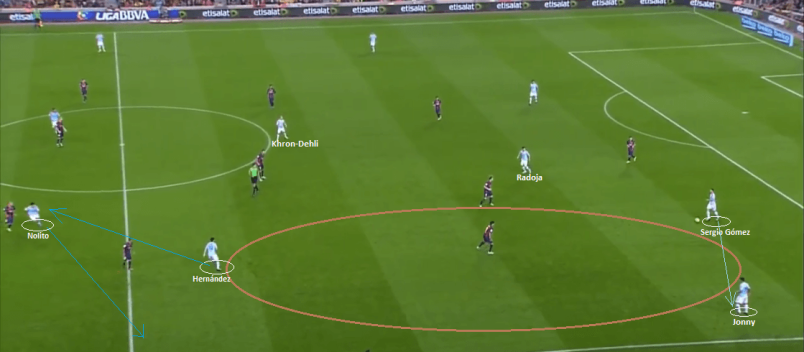
See this picture this what I am trying to show. The positioning of Radoja and Khron-Dehli, the Hernández and Nolito intercharging, were intended.
They let the huge space left as what it was and made the opponent thought Celta Vigo were losing their shape. But, it was not. This is how eduardo Berizzo way of escaping from opposing team high up pressing.
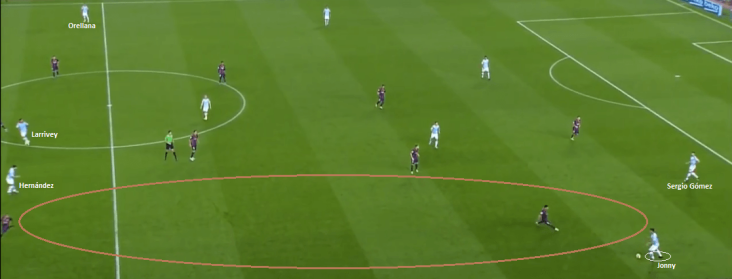
Jonny received the ball from Sergio Gomez. The gap was getting bigger. Take notice on Sergio Gómez. He stepped back. He did it as the part of the plan.
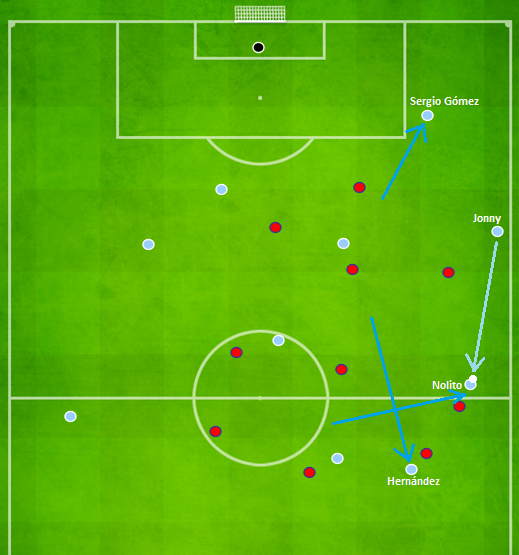
Celta Vigo huge gap was an intended play. And, it ended up with this. Nolito moved left and Hernández moved up.
The space was huge, see the previous picture, and Barcelona didn’t seem to be really occupying that space. It gave good opportunity for Jonny to passed the ball forward and escaped Celta from Barcelona pressing. He found Nolito on the wide area.
If you see Sergio Gómez stepped back, that was the back up plan. In case Jonny’s passing lane turned out to be canceled out by Barca, Gómez would be the other option.
https://www.youtube.com/watch?v=aJLVbifxI7o
Celta Vigo escape from Barcelona pressing
Here is another example how Celta play their football from behind. We start it from the moment just before they regain possesion (man to man challenge by Sergio Gómez on Messi). We’ll soon see the long ball plan on Celta Vigo tactic.
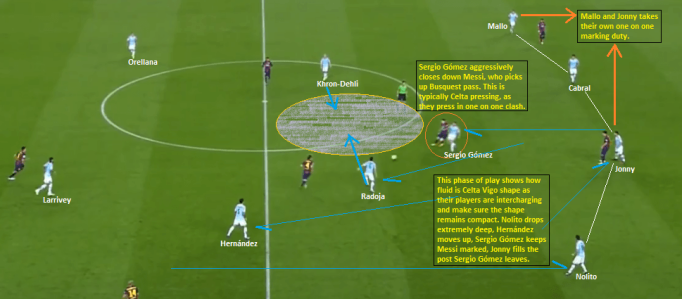
Celta defensive shape and pressing. In this phase of play. Nolito dropped deep to back line. It was all begun when Barcelona played from behind.
Nolito moved wide and deep, to try to cut Dani Alves space on the right side. His movement changed Celta shape from 4-3-3 to 5 men behind.
Busquest, who started from deep, found Messi on advanced central area. He gave the ball to Messi. Sergio Gómez saw it and immediately tried to stop Messi from play, by closing down him. Radoja and Khron-Dehli gave perfect support by controlling the space and, in turn, helped Celta regain possession, as Messi lost the ball.
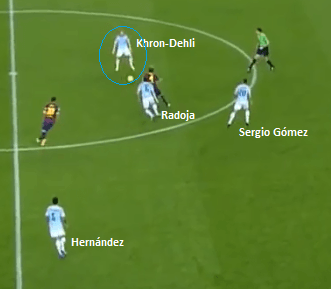
Celta regain possession. The ball then recycled by these three, Khron, Radoja, and Gómez, before being sent back to the back line.
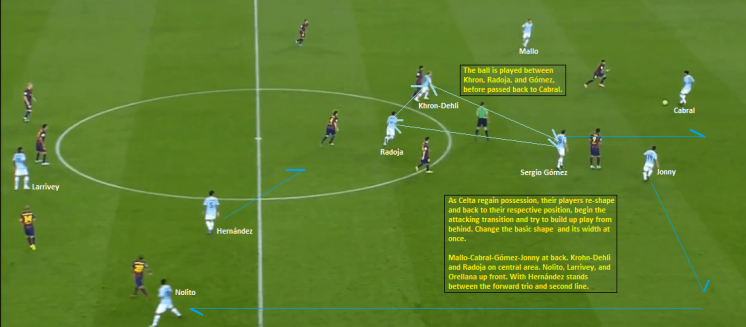
The transition after regain possession. Usually, when they are on attack or build up play, Radoja is the one acting as the deepest midfielder, being the “spare man” (for passing option when Celta are pressed, for example), and the shield for the back line as well.
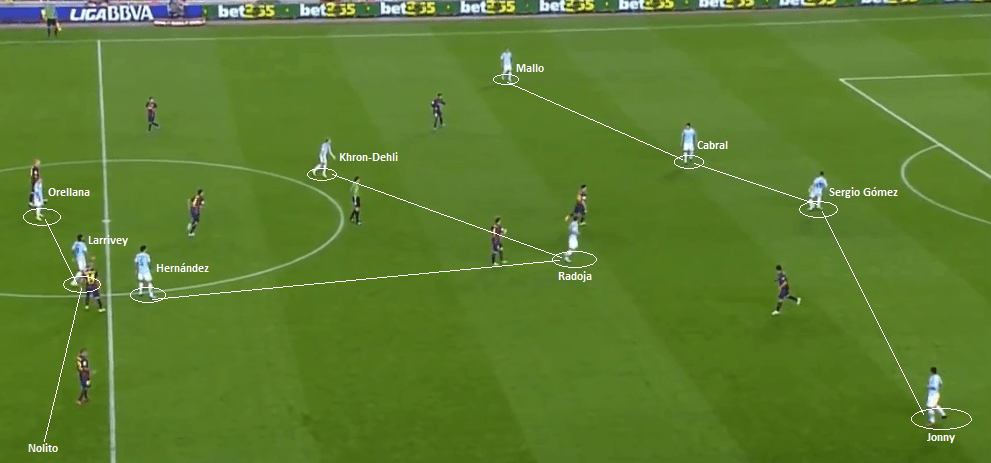
Celta shape as one of their build up play. They widen the shape. 2 players to occupy the central midfielder, with Radoja often plotted on defensive pocket post. 3 players to overload the Barcelona deepest defensive layer, on its central area. 1 another forward kept wide, it was Nolito (on left side but unseen on picture), to make a blind run from wide, to central area, tried to pick up the flicked on ball by Larrivey or Hernández.
Long Ball Plan on Celta Vigo Tactic
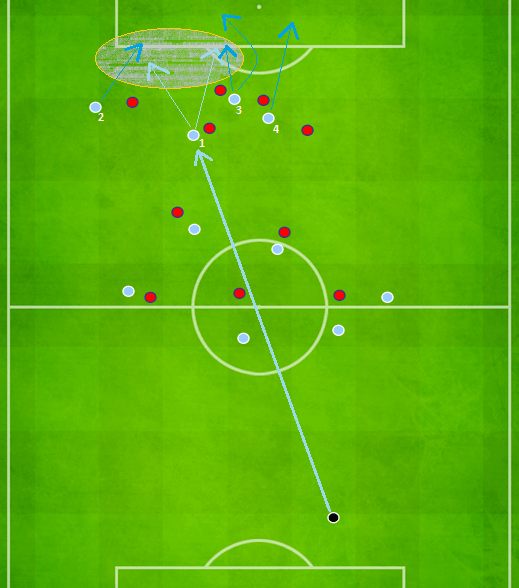
The long ball plan. Here was the simple plan of Berizzo long ball play. Player 1 is the main target (mostly Hernández or Larrivey, as the second choice). Player 2 and 3 are the target to reach by player 1 (Larrivey or both wingers alternately picks that duty). Player 4 (Nolito or Orellana).
In some of their matches, Celta built their attack patiently from behind by passing short and slowly. But, in this match, they preferred to go with direct long ball to Larrivey/Hernández and relying on their aerial ability. Plotting Hernández there, was the part of “rule of number”. It was intended to put as much players to keep Barcelona thinking and split their concentration. The absent of Pique, good at aerial duel, just made life harder for Barcelona. And, Berizzo, spotted it well by trying to exploit it as often as possible.
Many Celta players bothering Barcelona back line, also meant Celta were trying to maintain their pressure on to Barca back line. 4 players asked to stay on it.
If you see the previous picture, the one who carried the ball was, Sergio Gómez. He then played the ball long to Celta offensive line, with Larrivey or Hernández being the target man.
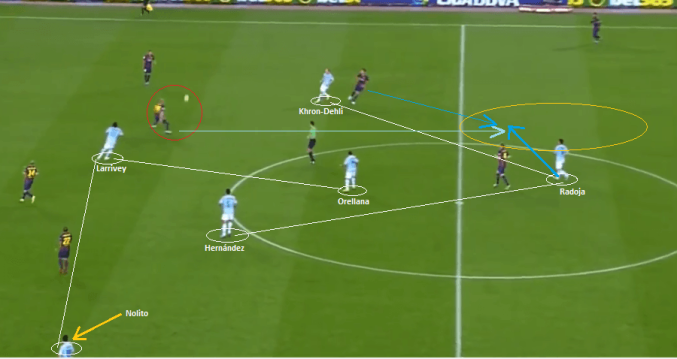
Situation after Gómez long ball. It was failed and picked up by Mathieu.
Radoja stayed deeper. Jeremy Mathieu passing indication (the light blue line) was where Mathieu would direct the ball. Radoja, as the deepest one, realized it perfectly and made an interception.
On another attacking phase, when Celta found no enough room to break the opponent defense, they restart the build up. They do it by, either holding up the ball or re-build the play from behind, invite opponent players to come, so there’ll be bigger room created which more easily. As the match were going on, the amount of long ball, played by Celta back line (mainly their GK), to the front line, was increasing and obviously being the Celta way of play. Here some of them.
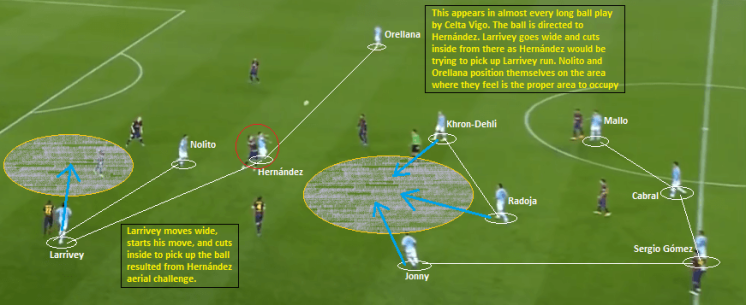
Celta Vigo long ball plan. The ball was kicked from GK and reached Hernández. He was expected to find Larrivey or one of Nolito / Orellana. In this occasion, Celta combined it by pressing Barcelona with their high defensive block.
This high d-block might be giving Celta two advantages. (1) they forced Barcelona behind. (2) there were more than 1 option for Hernández. Flicked on the ball to Larrivey, to the white cirled area, behind Nolito and Larrivey, was the first option. Or, headed the ball to the area where Khron, Radoja, and Jonny were ready to pick up, as another option.

Another long ball plan. 4-2-4 medium block to overload Barca back line. Another identical way of play. Long ball from GK to Hernández. Larrivey moved wide and ready to cut inside. Nolito and Orellana on the their post, splitting the concentration of Barca back line.
This was the moment of the match, as it lead to the only goal scored by larrivey. Álvarez long pass was flicked on by Hernández and reached Nolito, who ran from behind. He controlled it for a while, before releasing a back heel pass to larrivey. Celta Vigo overturn Barcelona.
https://www.youtube.com/watch?v=lhiNSy-sdcc
Larrivey goal against Barcelona
Man to man system, defensive shape, and attacking movement
As one of Bielsa disciple, it’s easy to guess that he would be happily deploying pressing play into his tactic. You can consider pressing play as the part of defensive-plan. It is the defensive art of modern football. If they press high up the pitch, it means Celta defense starts from their attacking line. Here it is.
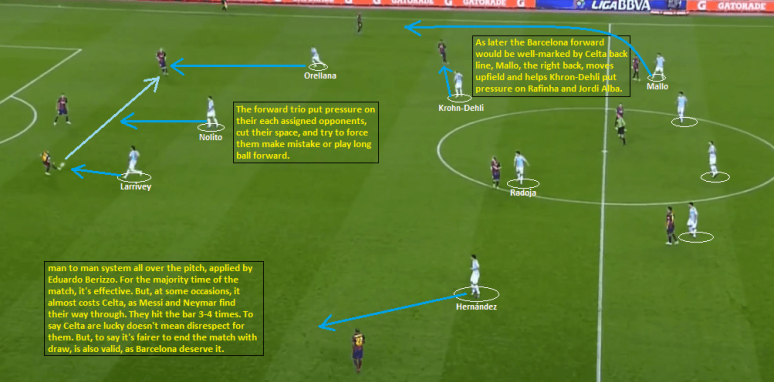
Phase one 3 v 3 situation. Three men up front, Larrivey, Nolito, and Orellana occupying their each assigned opposition players. Mascherano passed the ball to Mathieu. Khron-Dehli was concentrating on Rafinha.
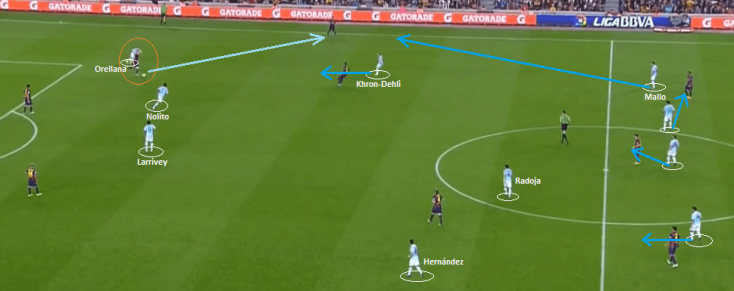
Phase two right back to get involved. Still with their man to man system. Orellana taken on by Mathieu. Khron-Dehli on the CMR was still tightly marking Rafinha. See the next pict, after Mathieu passed the ball to Alaba.
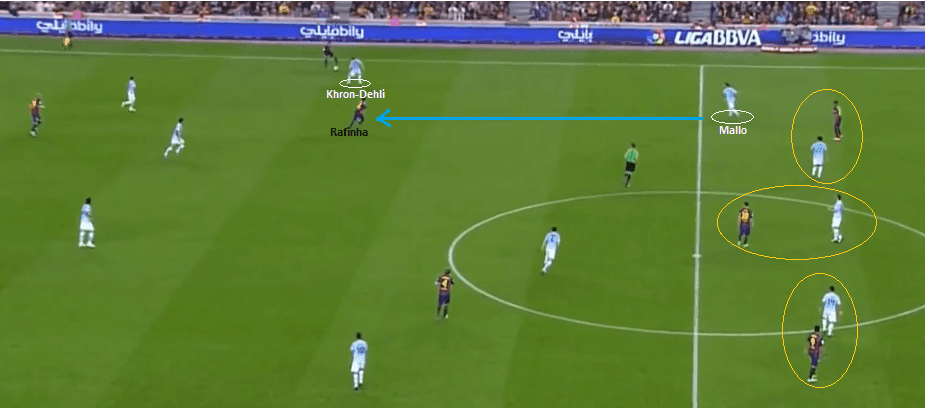
Phase three pressing. Celta Vigo pressed the left area. As Mallo realized the Barca trio were well-marked by three Celta defenders, he decided to move up field and cut the passing lane of Rafinha. Jordi Alba, the left back, was still under Khron-Dehli watch. As soon as Jordi alba released a pass (to Rafinha), Mallo who was on the right area, chased it, created 2 v 2 situation, and, finally, made a nice interception.
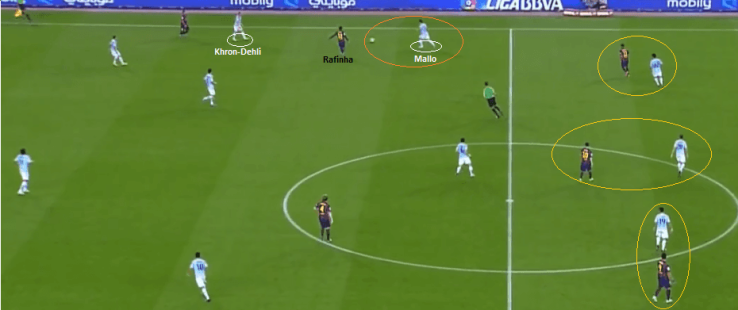
Phase four pressing. Jordi Alba made mistake. Mallo got the ball.
Celta Vigo man to man sytem on their own half, was no different with how they pressed Barcelona when the ball on the opposite area. Eduardo Berizzo still asked his boys to press the opponent in one on one situation. One player for one Barcelona player.
Berizzo didn’t apply a strictly man to man marking by asking one particular player to press/mark to specific Barcelona player. He believes the equation wouldn’t good for his side. Berizzo chose to alternately press as it the man-marking was more to a man-oriented in a specific zone or space one. At one time, it was Radoja who marked Messi, but, on other occasion, it was Sergio Gómez as Messi came into the different strategical area.
In a phase of pressing it could be two different players, alternately, pressed the same Barcelona player. “Alternately pressing system” or a man-oriented in a specific-zone, as I difficult to name it properly, sorry. If, for example, Jonny was pressing Suarez on the left side. As he put pressure on Suarez, Jonny would be keeping his distance to Suarez (he followed anywhere Suarez was going), but, in certain situation, when Jonny saw he’s roaming too far away, from his respective position, he might loose his pressing, leaving Suarez, and, at once, let another players (Cabral or Mallo), to press Suarez.
Another example of pressing, was, when a player (A) left his respective position, other player (B) had to fill that empty space. So the A could still maintain his pressing on the opponent player. This helps the team to keep the shape compact.
Here is one example, the man to man system on Celta own half, which also shows us the shape of Celta defense.
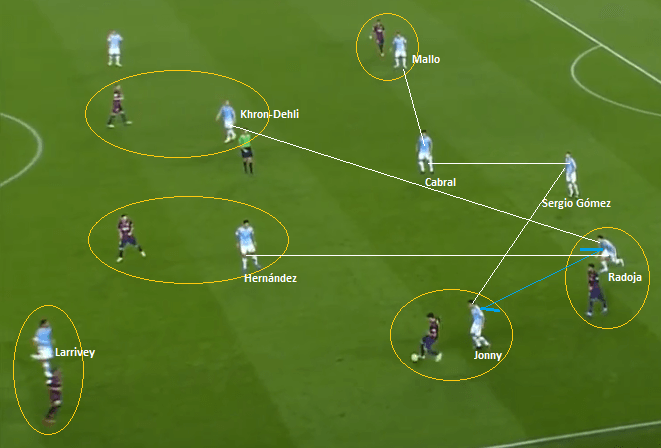
Defensive pressing phase 1. Suarez was carrying the ball. Jonny, the left back pressed him. Radoja the CM of Celta, occupied Jonny position (on the left side). Other players, Larrivey, Hernández, Khron-dehli, and Hugo Mallo, were each instructed to mark the nearest opposition.
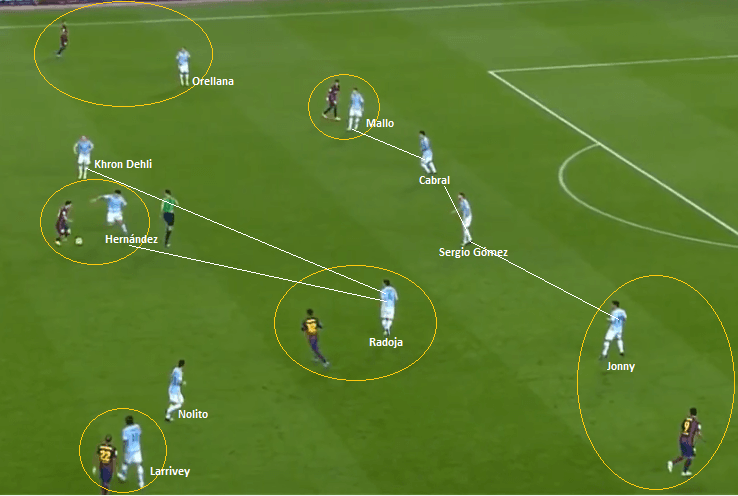
Defensive pressing phase 2. After couple of second it was Messi with ball. Radoja was back to his position in the middle area. Jonny back to the left back. As Nolito tracked back, Larrivey left his opposition and back to his position, on attacker slot.
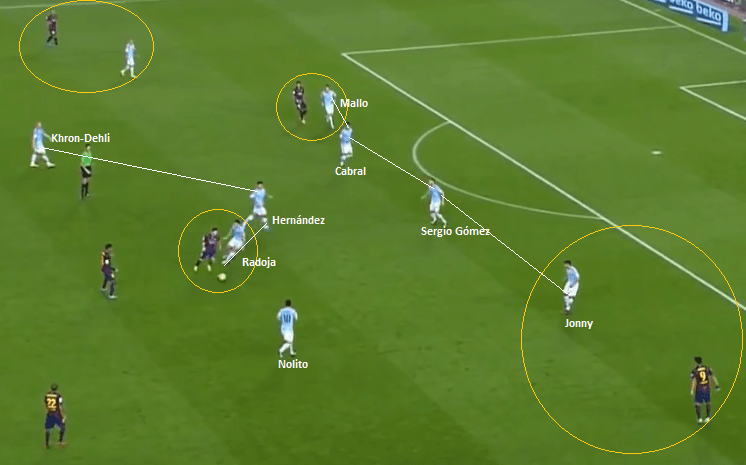
Defensive pressing phase 3. As Messi got further forward, trying to get into another zone, it was Radoja turn to press on him. Messi gave the ball to Suarez (lower right), Barcelona were getting closer to Celta Vigo box.
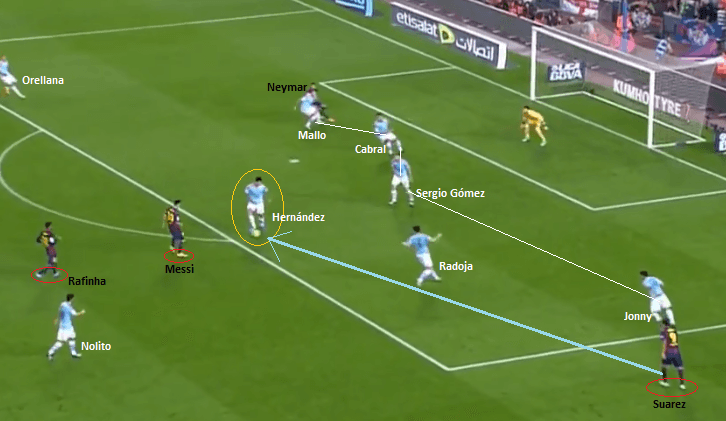
Defensive pressing phase 4. Hernández intercepted the pass. It was clearly seen, what plan Barcelona had here. As Suarez was out wide and there only Neymar in the box and overloaded, Messi deliberately kept his position outside, hoped to receive the cut-back and hit Celta from there instead of getting deep and tried to score a header. But, it was easily for Celta to defend against. They read it well. They marked Neymar and put player to occupy the zone 2/5 respectively.
And, here is another example of Celta Vigo man-oriented in a specific zone, how they defended against Messi.

A man-oriented an alternately pressing on Messi 1. Left picture, Sergio Gómez and Radoja closed down Messi. Radoja took the initiative to keep continuing pressing Messi, so Gómez reshaped and back to the back line.

Alternately pressing on Messi 2. Orellana and Radoja alternately pressed Messi.
Berizzo didn’t want to his team to pay special attention on certain player (Messi for example). He chose to press intensely, alternately, and on one on one clash (man-oriented system). He differs his pressing play to what Roger Schmidt or Jurgen Klopp loves to. In Klopp or Schmidt system, there could be 2 players as the main-press the ball carrier with 2 or 4 others covered the main-press, so team can regain possession in the possible fastest time and launch a quick counter-attack. Berizzo doesn’t do such pressing. His differes his approach, at least not as extreme as what the two German do. Not as fast as Schmidt or Klopp does, in term of attack.
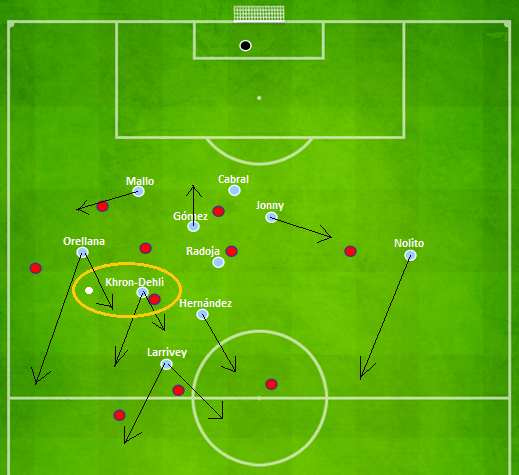
Celta Vigo attacking transition. Messi stopped by Dehli. The transition begun. The arrows were the movement indications of each Celta Vigo players, when they attack.
Mallo and Jonny (full backs) moved wide. Radoja acted as the deepest midfielder. Khron-Dehli, a winger-naturally, occasionally moved wide, but, mostly, in this match, he stayed on the central area, paired with Radoja.
This attack scheme (as shown on picture) begun from defensive phase, where the two wide strikers were sitting deep in line with Celta back line. By sitting deep, Nolito and Orellana, were having huge space to utilize. With Nolito and Orellana are both pacey, it allowed them to use their quickness.
Hernández was the striker-attacking midfielder hybrid, he often sit deeper than the front three. Larrivey was the central forward. But, when Orellana/Nolito inverted, he often seen moving wide and came inside at proper time.
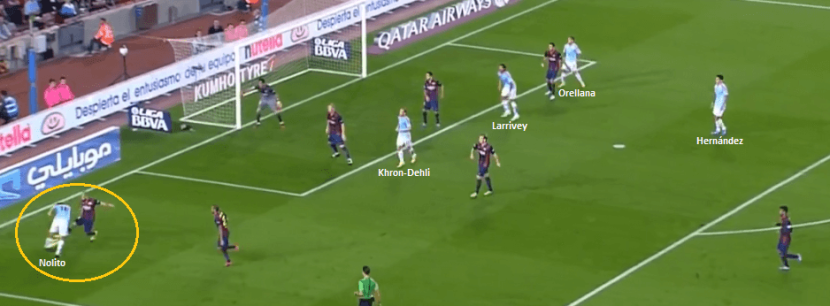
The attacking positioning. As Messi lost the ball, Celta recycled it quickly. Khron-Dehli to Orellana, with short and quick pass, and finally to Lolito. Khron Dehli then kept going forward and so did Larrivey and Orellana. They came deep into Barcelona box, waiting for float cross.
Celta often and obviously tried to hit Barca from wide area. With this in mind, when their second line are on possession, Celta played it patiently, waiting for diagonal runs from Nolito or Orellana, who sit narrow then moves wide. As that simple, the ball would be passed to the wide area, where the diagonal runner intended to.
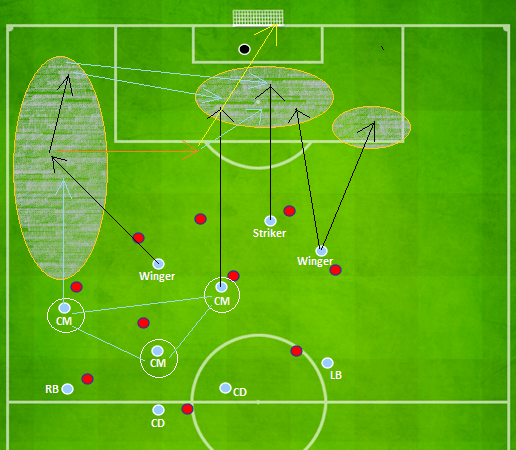
Wide play plan. The blue lines among three CMs, are the lines that show the possible patiently play, I mentioned above, on Celta second line. They play it slowly, as they wait for the winger to run diagonally (from central to wide area).
If the ball reaches that runner, it could be ended up by a float cross (Larrivey or Hernández as the target). Or, cut inside, which means Celta try to hit the opponent from central position (direct shot or a through pass), which indicates by orange and yellow arrows.
Here is another wide play.
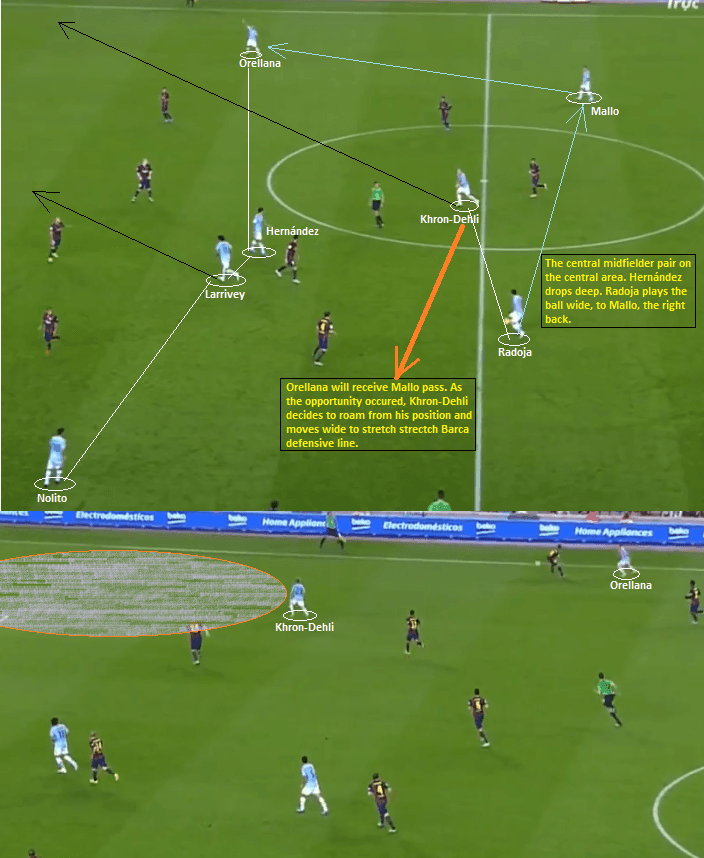
Another Celta Vigo wide play. Orellana pass, to Khron-Dehli, was failed by Jordi Alba who closed down him. Resulted another throw in for Celta. Had it reached Khron-Dehli diagonal run, we might see some possible options to take by him, identical possibilities with what I had mentioned beforehand (cross the ball or cut inside move).
On the second half, particularly in the final 1/3 of the match time, Celta seemed to trying to stretch Barca play through switching play directly from flank to flank. They did it mostly when the ball reached the final third of Barcelona deep area. It was seen on several ocassions. A long diagonal ball from right flank to the left flank.
As the match reached its final 5-8 minutes, Celta changed their way of defending. There were far deeper and defended with two banks of five (strikerless one). When Barcelona reached the final third, Radoja would occupy the zone 5 and tried to overload that area. Celta officially shut the shop and gave no space for Barcelona to get into. Celta stick to their man to man system, with deeper defensive line.
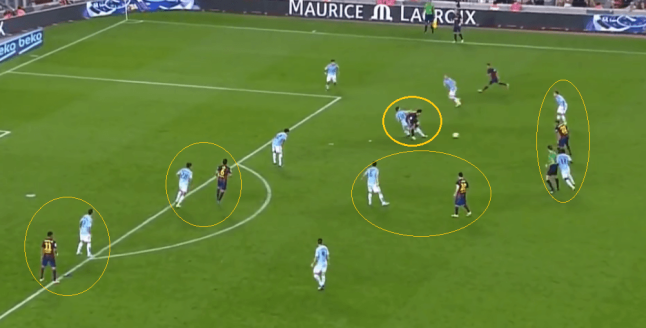
Stick to their man-oriented in a specific zone system.
Vulnerable side of Celta system.
In a man to man system, manager has to make sure his players are capable enough to play it. Things are getting complicated when you also want your team to press the opposing team intensely. In man to man marking system, a technically-gifted opponent player might be easier to find way through since he potentially beats his only marker.
A moment in 23:20 to 23:25 showed it perfectly, as Neymar beat Mallo in one on one clash. Neymar was free to make another pass to Messi.
Other moment which saw defensive error made by Celta defending player, was the moment minute 29:30. That was Messi who successfully defeated three players of Celta, before one-two passes with Neymar. Fortunately for Celta, Álvarez saved Messi’s shot. The error was made by Radoja and Sergio Gómez. Radoja, actually saw Messi movement, but, somehow he didn’t pick his run and let Messi got into the space. Gómez, as the one closest to Messi shooting area (the orange circle), also made not enough cover to close the space.
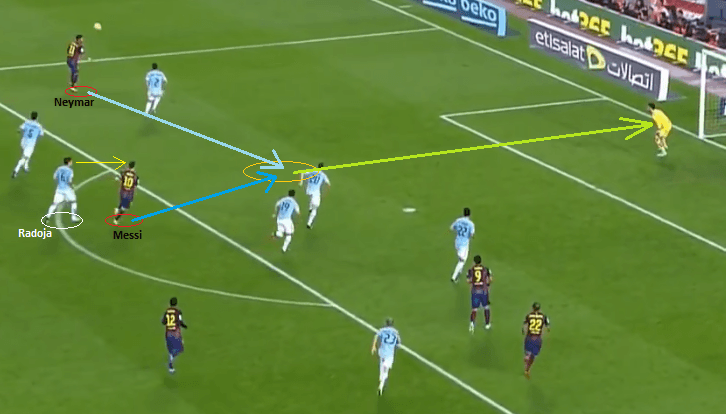
Radoja and Sergio Gómez defensive error. Take notice on Radoja position and body language (he turned his eyes to Messi), but, strangely, he did nothing and let Messi ran into that space instead. Gómez also made another mistake, as what mentioned beforehand.
https://www.youtube.com/watch?v=Guv5ed9DNns
Celta (individual) defensive error against Barca
Celta Vigo do not have a creative player who can be relied on his vision to control the play. They are all hard workers and some pacey players. There is no real creator. A deep creator who can be relied on their decent defensive awareness and excellent reading. You can mention, Ilkay Gundogan or Marco Verratti, as the model. Pablo Hernández is a good att midfielder/shadow striker, so is Khron-Dehli. Radoja suits to his job on defensive midielder post. But, again, they’re not creator, neither those three nor Nolito. When they’re off form and halt by stubborn defensive system, Celta might be too one dimensional, which negatively impacts to their play.
Conclusion
Not being disrespect to Celta Vigo, IMHO, the result was bit unfair for Barcelona, as they were got several very good chance of scoring. 4 from their total attempts hit the bar + 1 clear cut chance of heading by Suarez, that “strangely” directed to where Álvarez was, which finally was easily saved by the Celta goalie. But, win is still win. Celta Vigo showed resilient and great spirit. They have to be credited for that. They played their plan. Their long ball plan was the play to exploit Barca weakness on aerial duel. They combined it by trying to overload Barca back line and it resulted. They managed to overturn Barcelona, that’s all.
Barcelona, particularly Lionel Messi, in the first half, could still display good football. He ran the ball well and found some spaces. Overall, Barcelona were better in term of individual skill. For me, when asked to pick a MoTM for this battle, I’ll give you two options, Álvarez or Messi :).
For more updates, please follow our blog or follow Twitter @ryantank_
Thank you for visiting, reading, liking, or tweeting this piece

Pingback: Barcelona 2-1 Real Madrid : Equally Strong Tactical Battle | kynTnaRa